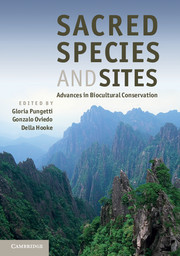Book contents
- Frontmatter
- Contents
- List of Contributors
- Foreword
- Preface
- Acknowledgements
- Introduction
- Part I Concepts and Knowledge
- Part II Sacred Landscapes
- 5 Ecological and spiritual values of landscape: a reciprocal heritage and custody
- 6 Sacred mountains and national parks: spiritual and cultural values as a foundation for environmental conservation
- 7 The history of English churchyard landscapes illustrated by Rivenhall, Essex
- 8 Exmoor dreaming
- Part III Sacred Sites and People
- Part IV Sacred Species
- Part V Sacred Animals
- Part VI Sacred Groves and Plants
- Part VII Implementation and Conclusions
- Index
- Plate Section
- References
5 - Ecological and spiritual values of landscape: a reciprocal heritage and custody
from Part II - Sacred Landscapes
Published online by Cambridge University Press: 05 August 2012
- Frontmatter
- Contents
- List of Contributors
- Foreword
- Preface
- Acknowledgements
- Introduction
- Part I Concepts and Knowledge
- Part II Sacred Landscapes
- 5 Ecological and spiritual values of landscape: a reciprocal heritage and custody
- 6 Sacred mountains and national parks: spiritual and cultural values as a foundation for environmental conservation
- 7 The history of English churchyard landscapes illustrated by Rivenhall, Essex
- 8 Exmoor dreaming
- Part III Sacred Sites and People
- Part IV Sacred Species
- Part V Sacred Animals
- Part VI Sacred Groves and Plants
- Part VII Implementation and Conclusions
- Index
- Plate Section
- References
Summary
Introduction: monks, mountains and forests
From antiquity, the landscape of mountains and forests has been associated with the sacred because it provided a natural sanctuary where human beings have felt they could approach the divine. The landscape came to have a symbolic significance favourable to a specific spiritual vocation, and in particular that of hermits.
Christian monasticism began in the deserts of Palestine and Egypt with the hermits (solitary monks) and the organisation of the earliest monastic communities. Although there are desert monasteries in the driest parts of Europe, e.g. Panayia Akrotiriani, Our Lady of the Cape, in Crete, mountains and forests were regarded as equivalent to the desert; indeed, they were sometimes called ‘deserts’, for example in the Cistercian and Carthusian traditions in western Europe and on Mount Athos, the holy mountain of Greece (Rackham, 2002). The same idea is present in other religions, for example Mount Hiei, the monastic mountain in Japan.
The forest, once thought of as a ‘natural’, uncontrollable, inhospitable space evoking fear of the unknown, came to be seen as the place best suited to an ascetic vocation because it offered the seclusion and silence that allow for listening, prayer and meditation. This is the practice that underpins the possibility of a balanced and ordered existence in harmony with nature and, according to religious tradition, oriented towards God.
- Type
- Chapter
- Information
- Sacred Species and SitesAdvances in Biocultural Conservation, pp. 65 - 82Publisher: Cambridge University PressPrint publication year: 2012
References
- 2
- Cited by



